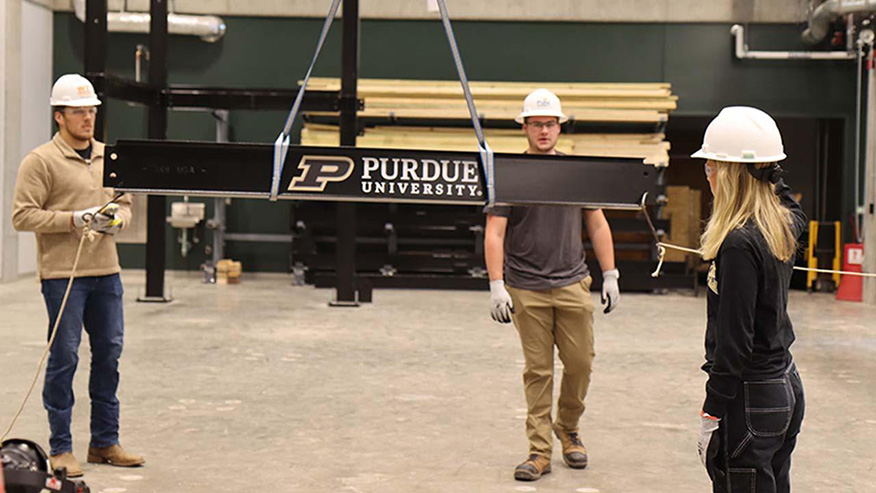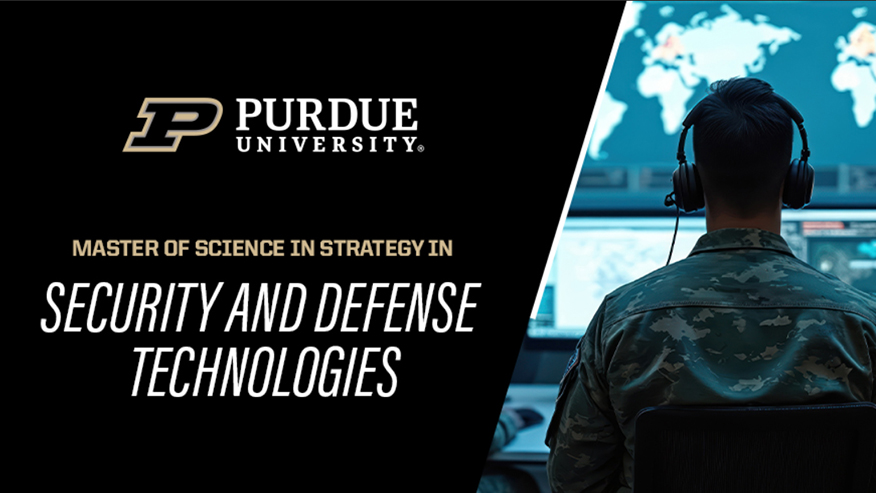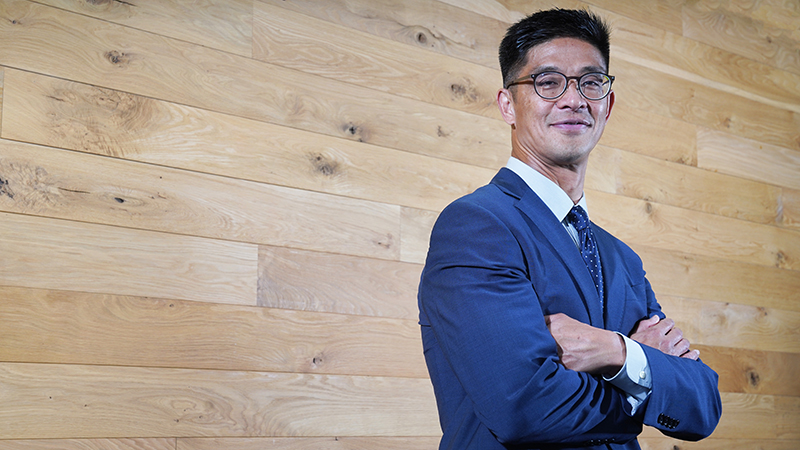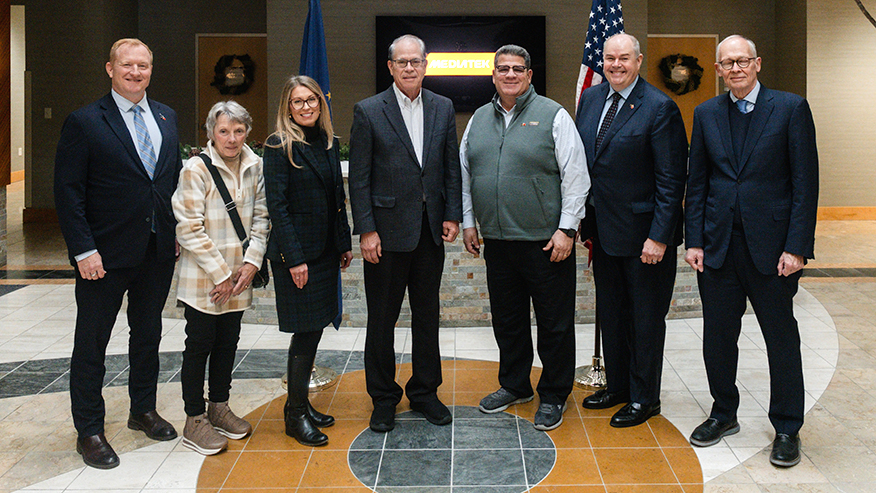Niche-filling new course meets aircraft and spacecraft industries’ workforce need
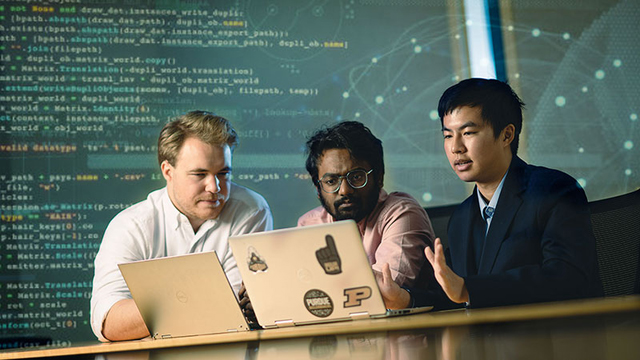
Students collaborate to develop an algorithm using industry-dictated aeronautical engineering principles that also allow for measurable cybersecurity. (Purdue University photo/Charles Jischke)
WEST LAFAYETTE, Ind. —
Purdue University is breaking new academic ground in optimizing student preparation for a dual-purpose workforce need in the space and aviation industries. The new Purdue Aviation and Space Cybersecurity course is giving engineering students much-valued, cyber-domain security proficiency while also providing aeronautical and astronautical engineering know-how to computer science and cybersecurity majors.
The course, which was launched in response to a need expressed by industry, represents a first.
“Aero and astro engineering graduates typically don’t have a solid understanding of cyber risks and vulnerabilities in the same way that our computer science or cybersecurity graduates do,” said Joel Rasmus, director of CERIAS, the Purdue Center for Education Research in Information Assurance and Security, who responded to industry members of the CERIAS Strategic Partnership Program in forming the new course. “Transversely, our cyber-focused students have not been prepared to understand the technical principles of size, weight and power, or other engineering specifics. Nobody else has this kind of a formalized, hands-on educational program. With this new curriculum, our graduates are better prepared to make significant technical contributions early in their careers.”
The need for this dual expertise is great and growing. Avionic systems — all aircraft systems that combine aviation and electronics — include communications, navigation, the display and management of multiple systems, and literally hundreds of systems that perform individual functions. Each one of these systems and functions is a potential target for malicious adversaries.
Purdue, which has long collaborated on research with the space and aviation industries, is uniquely positioned to prepare students for dual proficiencies. CERIAS, known worldwide for its leadership in cyber and cyber-physical security, supports more than 156 researchers from cross-cutting disciplines working on more than 150 research projects. Its research contributes to Purdue’s fourth-ranked cybersecurity educational program in the U.S. (CollegeValuesOnline.com), and its highly ranked U.S. computer science program from the College of Science. When that program is paired with Purdue’s fifth-ranked aeronautical and astronautical engineering program and other top-10 engineering programs such as industrial, mechanical, electrical and computer engineering, workforce preparation that is already highly ranked is taken to a new level.
Boeing is actively involved in the new Purdue program.
“We enthusiastically support Purdue’s launch of the Aviation and Space Cybersecurity course,” said Jeffrey Holland, Boeing research and technology. “Aerospace faces unique cyber threats and constrained design choices. Graduating students with this specialized awareness will benefit both the industry and students.”
The course is organized around real-world problem solving. Using problem scenarios contributed by industry members, teams of five to seven students work on solutions with Purdue faculty and industry mentors. Just as important to the course, however, is peer-to-peer learning.
“We want the students to learn from fellow students outside their normal domain,” Rasmus said. “Cybersecurity, computer science, data science, industrial engineering, aero and astro engineering and mechanical engineering students will all learn from each other while addressing a specific industry concern.”
For the course’s current inaugural semester, students are tackling a project sponsored by Boeing. Their charge — loosely described — is to develop an algorithm that leverages industry-accepted aero engineering principles while also addressing a need for measurable cybersecurity.
“For example, it may be easy for a cybersecurity student to address cyber risk by adding specialized equipment,” Rasmus said. “But on an aero platform, that recommendation must also consider whether the weight of the equipment necessitates engine adjustments or if it requires space that will remove passenger seats or impact fuel efficiency. This project-based course has the potential to provide new technology solutions for the space or aviation industries while it provides cross-training to students who will be better prepared to work both individually or as part of development teams within their post-university employment.”
Rasmus discussed the significance of this new course to the future of the space industry at the Oct. 19-20 Space Summit in Colorado Springs, Colorado. Sponsored by Space ISAC (Information Sharing and Analysis Center), the summit addressed “Securing the Value of Space.”
The importance of this dual-purpose course is underscored by Mark Lundstrom, interim dean of engineering, who is also the Don and Carol Scifres Distinguished Professor of Electrical and Computer Engineering.
“Our strengths in both interdisciplinary research and learning make Purdue the ideal choice to meet this industry need,” Lundstrom said. “Purdue graduates have a history of performing at high levels in the aero/astro industries as well as in cybersecurity, so building on these traditions with this cross-functional curriculum will give our students an even greater advantage in their post-Purdue careers.”
Purdue faculty and industry members are examining ways to grow and broaden the new aero-cyber educational workforce initiative. In the short-term, a certification program is being considered.
About Purdue University
Purdue University is a top public research institution developing practical solutions to today’s toughest challenges. Ranked in each of the last five years as one of the 10 Most Innovative universities in the United States by U.S. News & World Report, Purdue delivers world-changing research and out-of-this-world discovery. Committed to hands-on and online, real-world learning, Purdue offers a transformative education to all. Committed to affordability and accessibility, Purdue has frozen tuition and most fees at 2012-13 levels, enabling more students than ever to graduate debt-free. See how Purdue never stops in the persistent pursuit of the next giant leap at https://stories.purdue.edu
Writer/Media contact: Amy Raley, araley@purdue.edu
Source: Joel Rasmus, jrasmus@purdue.edu
